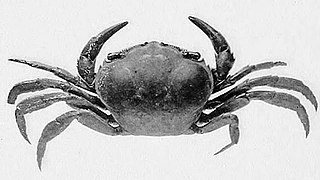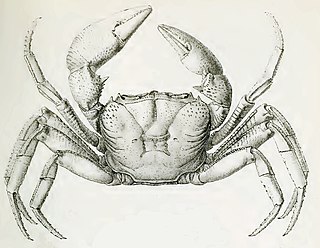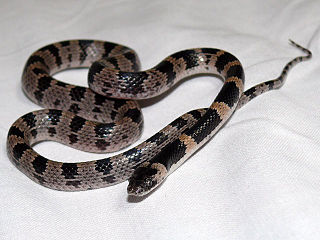
Oreochromis is a large genus of oreochromine cichlids, fishes endemic to Africa and the Middle East. A few species from this genus have been introduced far outside their native range and are important in aquaculture. Many others have very small ranges; some are seriously threatened, and O. ismailiaensis and O. lidole possibly are extinct. Although Oreochromis primarily are freshwater fish of rivers, lakes and similar habitats, several species can also thrive in brackish waters and some even survive in hypersaline conditions with a salinity that far surpasses that of seawater. In addition to overfishing and habitat loss, some of the more localized species are threatened by the introduction of other, more widespread Oreochromis species into their ranges. This is because they—in addition to competing for the local resources—often are able to hybridize.

Haplochromis is a ray-finned fish genus in the family Cichlidae. It has been used as the default "wastebin taxon" for Pseudocrenilabrinae cichlids of the East African Rift, and as such became the "largest" fish "genus". Many of these cichlids are popular aquarium fishes; like similar Haplochromini they are known as "haplos", "happies" or "haps" among aquarium enthusiasts.

Haplochromis retrodens is a species of cichlid fish endemic to Lake Victoria in East Africa. The species is a representative of the genus Haplochromis,

Gyraulus is a genus of small, mostly air-breathing, freshwater snails, aquatic pulmonate gastropod mollusks in the family Planorbidae, the ram's horn snails.

The Sakhalin sturgeon or Mikado sturgeon is a species of fish in the family Acipenseridae. It is found in Japan and Russia.

Alcolapia alcalica, the common natron tilapia or soda cichlid, is an endangered species of fish in the family Cichlidae. It is endemic to the hypersaline, warm Lake Natron in Ngorongoro District of Arusha Region, its drainage and the Shombole Swamps in Kenya and Tanzania. This species typically has an essentially terminal (straight) mouth, but a morph with an upturned mouth is found locally in eastern Lake Natron, where it co-occurs with the normal morph. A. latilabris and A. ndalalani, the two other species in Lake Natron, both have a clearly downturned mouth. Territorial males of A. alcalica have extensive blue-white spotting, and their underparts and throat can be yellow or white. Females and non-territorial males are overall sandy in colour. A. alcalica reaches up to 11.6 cm (4.6 in) in total length.
Nothobranchius neumanni is a species of killifish in the family Nothobranchiidae. It is endemic to Tanzania. It occurs in both perennial and seasonal wetlands including rivers, lakes and ponds where it most likely feeds on planktonic crustaceans. This species was described as Fundulus neumanni by Franz Hilgendorf in 1905. The specific name honours Hilgendorf's companion on some of his expeditions to Africa, the German ornithologist Oscar Neumann (1867-1946).

Synodontis afrofischeri, known as Fischer's Victoria squeaker, the marbled Victoria squeaker, Fischer's catfish, or the Victoria synodontis, is a species of upside-down catfish native to Kenya, Rwanda, Tanzania and Uganda. It was first described by German zoologist Franz Martin Hilgendorf in 1888, based upon a holotype discovered in Lake Victoria. The specific name "afrofischeri" is in honor of the German researcher Dr. Gustav Fischer, a German explorer of Africa.
Rotundopotamonautes emini is a species of crab in the family Potamonautidae. It is found in the Rwenzori Mountains between Lake Edward and Lake Albert in the Democratic Republic of the Congo, Rwanda, Tanzania, and Uganda. It is listed as Least Concern on the IUCN Red List.
Rotundopotamonautes pilosus is a species of crustacean in the family Potamonautidae. It is found in the wetlands of Kenya and Tanzania.

Arcopotamonautes platynotus is a species of freshwater crab which is endemic to Lake Tanganyika, where it is the only freshwater crab outside the genus Platythelphusa. Although primarily aquatic, A. platynotus is sometimes seen out of water, and can survive for many hours without water.
Arcopotamonautes raybouldi is a species of freshwater crab. It lives in water-filled tree holes in forests in the eastern Usambara Mountains of Tanzania and the Shimba Hills in Kenya. It is threatened by deforestation resulting from the expansion of the human population, and is listed as a vulnerable species on the IUCN Red List. The species was described in 2004, and named after Professor John N. Raybould of the University of Bristol, who collected the first specimens of the species.
Arcopotamonautes suprasulcata is a species of crustacean in the family Potamonautidae. It is found in the wetlands of Malawi, Tanzania, and Zambia.

Potamonautidae is a family of freshwater crabs endemic to Africa, including the islands of Madagascar, the Seychelles, Zanzibar, Mafia, Pemba, Bioko, São Tomé, Príncipe and Sherbro Island. Fossil remains dating from the Late Miocene period have been attributed to the family Potamonautidae.

Deckenia is a genus of freshwater crabs from East Africa, in the family Potamonautidae, or sometimes in a family of its own, Deckeniidae. The genus was named by Hilgendorf after Karl Klaus von der Decken who collected the first examples during his expeditions to Africa. Both species live in swamps from Eyl in Somalia to Dar es Salaam, Tanzania, both in coastal areas and further inland. A third species, Deckenia alluaudi, lives in the Seychelles, and has been transferred to a separate genus, Seychellum.

Franz Martin Hilgendorf was a German zoologist and paleontologist. Hilgendorf's research on fossil snails from the Steinheim crater in the early 1860s became a palaeontological evidence for the theory of evolution published by Charles Darwin in 1859.

Seychellum alluaudi is a species of freshwater crab endemic to the Seychelles, and the only true freshwater crab in that country. It lives in rainforest streams on the archipelago's granitic high islands. Although it may be abundant, little is known about its biology. If its habitat were to decline in quality, S. alluaudi might become endangered, but it is currently listed as Vulnerable on the IUCN Red List.

Hilgendorf's tube-nosed bat is a species of vesper bat in the family Vespertilionidae. In Japan they are called 'tengu komori', after the mythical creature called the Tengu. It was formerly thought to be a subspecies of Murina leucogaster, but is now known to be a distinct species.

The Oriental odd-tooth snake, sometimes called the Japanese odd-tooth snake, is a species endemic to Japan, belonging to the family Colubridae. It is found in Hokkaido, Honshu, Shikoku, Kyushu, the Goto Islands, Iki Island, Izu Ōshima, the Oki Islands, Sado Island, Tanegashima, and Yakushima. It has also been reported in Shiashkotan, one of the Chishima Islands.

Pseudocrenilabrus philander or the southern mouth-brooder is a small species of haplochromine cichlid found in southern and central Africa. It was first described by the German-Dutch zoologist Max Carl Wilhelm Weber in 1897.















